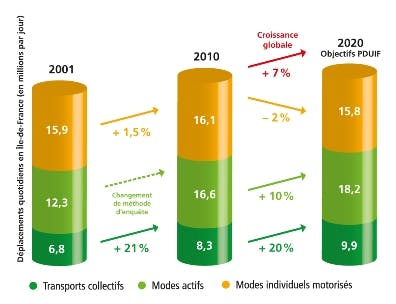The actions of the PDUIF
To achieve the objectives of the PDUIF, it is necessary to change travel conditions and behaviours. The PDUIF sets out nine challenges to be met to achieve this; Challenges 1 to 7 are about travel conditions and challenges 8 and 9 are about behaviours.
These 9 challenges are broken down into 34 actions, 4 of which are prescriptive. The implementation of these actions is based on the mobilization of all mobility stakeholders in the Île-de-France region.
CHALLENGE 1: Build a city that is more conducive to walking, cycling and public transit
- Action 1.1 Act at the local level for a city that is more favourable to the use of alternative modes of transport to the car
CHALLENGE 2: Making public transit more attractive
- Action 2.1 A strengthened and more efficient rail network
- Action 2.2 A modernised and extended metro
- Action 2.3 Tramway and T Zen: a structuring transport offer
- Action 2.4 A more attractive bus network
- Action 2.5 Develop high-quality multimodal interchange hubs
- Action 2.6 Improving passenger information on public transport
- Action 2.7 Facilitate the purchase of transport tickets
- Action 2.8 Enable occasional users to benefit from the Navigo contactless pass
- Action 2.9 Improving taxi traffic conditions and facilitating their use
CHALLENGES 3 and 4: Restoring the importance of walking in the travel chain and breathing new life into cycling
- Action 3/4.1 Pacifying the roads to give priority to active modes of transport
- Action 3/4.2 Reducing the main urban cuts
- Action 3.1 Designing the street for pedestrians
- Action 4.1 Make roads cyclable
- Action 4.2 Promote bicycle parking
- Action 4.3 Encourage and promote cycling among all audiences
CHALLENGE 5: Acting on the conditions of use of individual motorized modes
- Action 5.1 Achieving an ambitious road safety target
- Action 5.2 Implement public parking policies for sustainable mobility
- Action 5.3 Supervise the development of private parking
- Action 5.4 Optimize road operations to limit congestion
- Action 5.5 Encourage and develop the practice of carpooling
- Action 5.6 Encourage car-sharing
CHALLENGE 6: Make the entire travel chain accessible
- Action 6.1 Making roads accessible
- Action 6.2 Make public transport accessible
CHALLENGE 7: Rationalise the organisation of goods flows and promote the use of waterways and trains
- Action 7.1 Preserve and develop logistics sites
- Action 7.2 Promoting the use of the waterway
- Action 7.3 Improving the rail transport offer
- Action 7.4 Contribute to a more efficient road freight transport system and optimise delivery conditions
- Action 7.5 Improving the environmental performance of freight transport
CHALLENGE 8: Build a governance system that empowers actors in the implementation of the PDUIF
CHALLENGE 9: Make Ile-de-France residents responsible for their travel
- Action 9.1 Develop travel plans for companies and administrations
- Action 9.2 Develop school travel plans
- Action 9.3 Provide comprehensive, multimodal information accessible to all and develop mobility advice
Environmental actions
ENV1 Supporting the development of new vehicles
ENV2 Reducing transport-related noise pollution
In addition to implementing actions concerning public transport, Île-de-France Mobilités is in charge of coordinating and evaluating the PDUIF.

